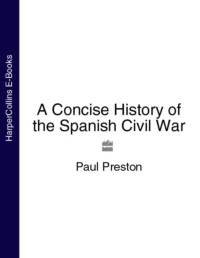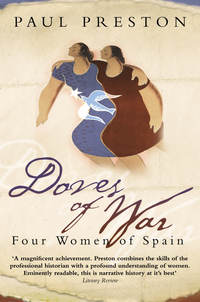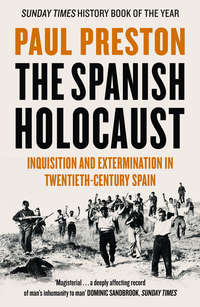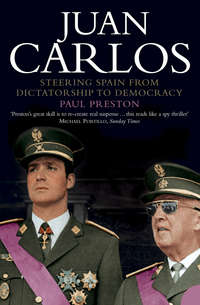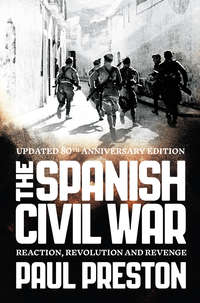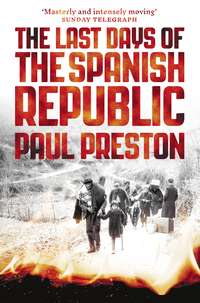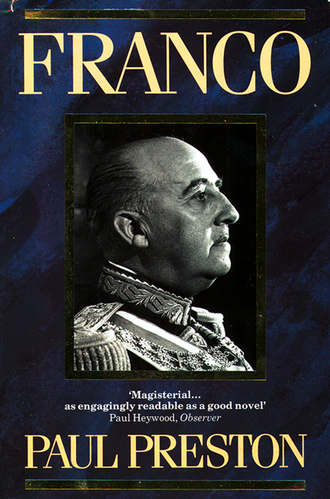
Полная версия
Franco
However, a different kind of war was about to begin. From 18 July until 7 October, the brunt of the Nationalist effort had been borne by the Army of Africa, on a forced march, frontally attacking towns and villages and opposed only by untrained amateur militiamen. It was little different from the kind of colonial war in which Franco and the other Africanistas had received their early military experiences. In this type of warfare, the advantage was entirely with the Legion and the Regulares. Henceforth, there was to be a move towards a war of fronts. Paradoxically, as the Germans, Italians and Russians poured in material assistance in the form of the latest weaponry, in part at least by way of experiment for the next war, Franco would remain fixed in the strategic world of the Great War.
More than with the attack on Madrid, the Generalísimo was occupied with the operation to break the siege of Oviedo and the city’s liberation on 17 October gave him enormous pleasure. He seems to have taken less direct interest in the campaign for Madrid. It was not until 20 October, considerably after the diversion of the Army of Africa to Toledo, that he seemed to wake up to the extent to which the capital was being strengthened and issued the order to ‘concentrate maximum attention and available combat forces on the fronts around Madrid’.4 Indeed, his absence from the operations to take Madrid, and from the subsequent Nationalist chronicles thereof, was quite remarkable. Perhaps Franco suspected that there was little easy glory to be won and thus slyly left Mola to take responsibility.
Mola himself was happy to seize the opportunity to make good his failure to capture Madrid at the beginning of the war.5 His optimism was widely shared: a Nationalist alcalde (mayor) and city councillors had already been named.6 Nationalist radio stations broadcast the news that Mola was preparing to enter the Puerta del Sol in the centre of Madrid on a white horse. He even offered to meet the Daily Express correspondent there for a coffee and Republican wags set up a table to await him.7 Nationalist aircraft showered Madrid with leaflets containing an ultimatum for the evacuation of the civilian population and total surrender. The situation was deteriorating so rapidly that there seemed little hope.8 Then on 15 October, the first arms and equipment from the Soviet Union began to be unloaded at Cartagena. Once the fifty tanks, twenty armoured cars and 108 fighter aircraft were assembled and transported to the Madrid front, giving the Republic a brief parity of force, there would be no quick victory for the Nationalists.9
By the end of the month, Mola’s forces had taken a ring of small towns and villages near the capital, including Brunete, Móstoles, Fuenlabrada, Villaviciosa de Odón, Alcorcón and Getafe. Madrid was inundated with refugees from the surrounding villages along with their sheep and other farm animals.10 There were major problems of food and water distribution. Harassed by Nationalist aircraft, the militia columns were also falling back along the roads to Madrid in considerable disarray. On 31 October, with twenty-five thousand Nationalist troops under Varela about to reach the western and southern suburbs of Madrid, Mola issued a warning about the dangers of further delay.11
However, from 1 to 6 November, there was a serious slowing-down of the advance, usually attributed to the Nationalists’ need to rest their troops and their confidence that they had time to do so. However, it has been alleged that the hesitation was in part caused by Franco making long consultations with his German and Italian advisers.12 It would also appear that between 4 and 6 November, an acrimonious debate took place within the Nationalist camp as to how to go about seizing the capital. Yagüe and Varela proposed daring blitzkrieg attacks through the suburbs, while Mola called for a broad frontal assault in the belief that Madrid would offer no more resistance than Toledo.* A cautious Franco rejected the plans of Yagüe and Varela for fear of losing the crack African columns.13
Franco thus left Mola free to push his own over-optimistic strategy of a full-scale assault from the west across the River Manzanares and through the University City and the Casa del Campo, the old royal hunting ground of sparsely wooded scrub. By 7 November, the Nationalists were ready to begin what they assumed would be their final frontal assault.14 On 28 October, the Falange and the Carlists drew up lists of the buildings, hotels, cinemas, theatres, radio stations and newspapers that they planned to occupy after the victory.15 Civilian rightists who followed in the wake of the Army of Africa had packed their suitcases in anticipation of an early return to their homes in Madrid’s better neighbourhoods. It was believed in the Francoist camp that, within hours, Legionarios would be in the Puerta del Sol.16
However, the news of the arrival of Russian weaponry and technicians along with the first 1,900 men of the International Brigades diminished the optimism at the Generalísimo’s headquarters. Heavy Russian tanks were put into action from the end of October to blunt the advance of the fast-moving Nationalist columns, although the lack of skilled drivers and gunners dramatically diminished their efficacy. Soviet I-15 and I-16 fighter aircraft piloted by Russian airmen went into action for the first time on 4 November and would, for about six months at least, reverse the easy air superiority enjoyed by the Nationalists during the drive on Madrid.17 Without knowing fully the scale of the Russian aid to the Republic, the Germans were already becoming frustrated with the slowness of Franco’s progress towards Madrid.
The German Foreign Minister Constantin von Neurath complained to Ciano on 21 October about Franco’s inactivity on the Madrid front.18 Shared concern about the fate of the Nationalist cause was one of the many factors pushing Italy and Germany together. Indeed, Mussolini was soon to start talking of the Rome-Berlin Axis. Both Ciano and von Neurath expected Madrid to fall by the end of the month or in the first week of November at which point they planned to extend formal recognition to Franco.19 At the end of October, however, the German Minister of War, General von Blomberg, sent Admiral Canaris and General Hugo Sperrle to Salamanca to investigate the reasons for Franco’s failure to take Madrid. Von Blomberg had instructed both Canaris and Sperrle to inform Franco ‘most emphatically’ that the German government did not consider his ground and air combat tactics ‘promising of success’ and that ‘continued adherence to this hesitant and routine procedure (failure to exploit the present favourable ground and air situation, scattered employment of the Air Force) is even endangering what has been gained so far.’
Canaris and Sperrle were to inform Franco of the conditions under which he would receive future reinforcements. The German units would be under the command of a German officer, who would be Franco’s sole adviser on their use and responsible only to him. Franco’s command would be maintained only ‘outwardly’. The consolidation of German forces was conditional on the ‘more systematic and active conduct of the war’ and the Generalísimo’s acceptance of these demands ‘without reservation’.20 Once the Generalísimo had agreed, a complete battle group under General Sperrle, known as the Condor Legion, was assembled and despatched with astonishing speed. Within a matter of days, a force of specialised units, equipped with the latest developments in German bomber and fighter aircraft and tanks and other motorised weapons was en route to Seville. Five thousand Germans landed in Cádiz on 16 November and a further seven thousand on 26 November along with artillery, aircraft and armoured transport.21
So sure was the Republican government that Madrid would fall that, after acrimonious discussions, it left for Valencia on 6 November. With Nationalist artillery shells falling on the suburbs, it seemed to be the beginning of the end.22 The organization of the city’s defence was placed in the hands of a Defence Junta presided over by the recently appointed Captain-General of New Castile, José Miaja.23 The portly, balding fifty-eight year-old Miaja was despised by Franco as incompetent and scruffy and regarded by Queipo de Llano as inept, stupid and cowardly.24 Known largely for the abortive counter-attacks which had failed to stop Franco’s advance through Extremadura, Miaja was assumed by many, including himself, to have been chosen as the scapegoat to take the blame for the fall of the capital.25
The bluff and good-humoured Miaja quickly surrounded himself with a staff of highly competent assistants, of whom the most outstanding was to be his Chief of Staff, Lieutenant-Colonel Vicente Rojo. While Rojo planned the defence, Miaja worked on raising the morale of the defenders. Unaware that Miaja was anything more than a sacrificial victim, Franco announced on 7 November that he would attend mass in Madrid on the next day. On the morning of 8 November, congratulatory telegrams to Generalísimo Franco from the governments of Austria and Guatemala were delivered at the Ministry of War in the capital.26 Lisbon Radio also jumped the gun by describing in detail the frenetic welcome that he received from the people of Madrid. The American Hearst Press’s sensationalist correspondent, H.R. Knickerbocker, wrote a detailed description of the victory parade, ‘from the steps of the Telefónica’, which even included the customary barking dog following behind.27 The British journalist Henry Buckley was told by a news editor in London that his story of fighting in the outskirts must be wrong because it was known that Franco’s forces were in the centre of the city.28
Miaja and Rojo faced a frightening situation. They had little or no idea of the scale, disposition or readiness of the forces at their disposal. There was a shortage of rifles and ammunition, no anti-aircraft cover and little or no radio liaison between the random collection of arbitrarily armed irregulars whose only asset was their determination to defend the city to the death. Miaja and Rojo were fully aware of the skill and aggression of the Legionarios and Regulares about to hit them. They also knew of the numerous and well-organized fifth column of Nationalist supporters carrying out sabotage and ready to rise in the city.29
Varela, understandably confident that Madrid would fall easily in the light of the government’s desertion, delayed in launching the attack in order to allow his troops to rest. He had faced virtually no resistance on 5 November. Had he attacked on 6 November when demoralization still gripped the population, he might have had an easy victory.30 As it was, Rojo and Miaja were able to spend the night of 6 November and the entire day and night of the seventh organizing the disparate forces at their disposal. Rojo was blessed even more by the fact that on the night of 7 November Varela’s detailed battle plan was found in a captured Nationalist tank.31 Curiously, the departure of the indecisive government of Largo Caballero seemed to take with it the blanket of pessimism and the proximity of Franco’s forces wiped away internecine political squabbles.32
In the silent streets of the capital on the night of 7 November, the defenders were united by tormenting thoughts of what had happened after the Army of Africa had entered Badajoz and Toledo. Nevertheless, there was a popular determination to fight to the last.33 Along with the Communist Party’s Fifth Regiment, the most highly organised and disciplined force in the central zone, the 1,900 men of the Eleventh International Brigade helped Miaja to lead the entire population of Madrid in a desperate and remarkable defence. Inspired by Miaja’s jocular bluster and guided by Rojo’s brilliant use of Varela’s battle plan, the ordinary citizens of Madrid, with aged rifles and insufficient cartridges, dressed only in their civilian clothes, halted the Nationalist forces.34 In the course of the attack – launched in brilliant autumn sunshine on 8 November – the Army of Africa suffered casualties on a scale hitherto unknown as it battled to cross the Manzanares, which is dominated from above by the terrace-like avenue known as the Paseo de Rosales. Major Antonio Castejón, the most fiercely energetic of Franco’s column commanders, was seriously wounded. With his hip shattered, Castejón, depressed by the high casualties among his Moors, told the American journalist John Whitaker, ‘We made this revolt and now we are beaten.’35
Varela’s attack through the Casa de Campo had faltered by 10 November at the cost of the lives of one third of the men of the International Brigades. When the Manzanares was finally crossed on 15 November, there was hand-to-hand fighting between them and the Moors in the University buildings.36 Defending their city, with their backs to its walls, the working-class militia were much more of a match for the Moors than they had been in open scrub land. However, after the arrival on 12 November of the Condor Legion, working-class districts were shelled and bombed more systematically than before, although the Generalísimo was careful to try to spare the plush Barrio de Salamanca, the residential district where many of his fifth columnists lived and other important rightists with his forces had their homes. The Germans were anxious to experiment with terror bombing. The damage was massive, the military impact negligible.37 In deciding to try to terrorize Madrid into submission, and permitting the incendiary bombing of a city bulging with Spain’s art treasures, Franco had cast aside the pretence that he was not prepared to damage the capital. He had told Portuguese journalists that he would destroy Madrid rather than leave it to the Marxists.38 The American Ambassador wrote to Washington: ‘it is currently reported that the former King, Alfonso, has protested against this policy to Franco. If he is responsible it can only come from the fact that in his humiliation over his failure to take Madrid in a few days, he has permitted his resentment to get the better of his judgement.’39
By 22 November, the Nationalist attack was repulsed.40 On the following day, Franco and his Chief of Staff, Colonel Martín Moreno, travelled from Salamanca to Leganés on the outskirts of Madrid. The Generalísimo addressed a meeting of Mola, Saliquet, Varela and their respective general staffs. Without massive reinforcements which he simply did not have, there was no choice but to abandon the attack. The Generalísimo ordered an end to frontal assaults on the grounds of the weakness of his forces, the foreign assistance received by the Republic and the difficult tactical situation of the Nationalist Army, given its reliance on long exposed lines of supply and communication.41 Orgaz would take over the forces on the Madrid front, Mola those in the north. Franco’s forces had suffered their first major reverse.42 However, instead of taking the militarily sensible decision of withdrawing to easily defended lines four or five kilometres from the city, Franco revealed his obstinate determination never to give up an inch of conquered ground. He thus ordered Asensio to fortify the positions taken in the University City in order, as he perceived it, to maintain a psychological and moral advantage, irrespective of the cost which, in the next three months, would be considerable.43
Franco was immensely fortunate that the Republican forces in Madrid were too depleted to mount a serious counter-offensive. If they had, the tide might well have turned decisively in their favour. Totally disconcerted by the losses suffered by their men, Varela and Yagüe had told Captain Roland von Strunk, a German military observer in Spain, in the presence of John Whitaker, ‘We are finished. We cannot stand at any point if the Reds are capable of undertaking counter-attacks.’ Captain von Strunk was in total agreement, convinced that only German reinforcements could save Franco from defeat. He commented bitterly to the US Consul in Seville that ‘Franco could have captured Madrid on the first day’ and added that he had informed Franco that he must accept German direction of the campaign or else Germany would withdraw its material and Franco had accepted.44 In Paris, in Rome, in Morocco, as well as in the Nationalist tents around Madrid, it was believed that if Franco did not get more help from Germany and Italy, his movement would collapse.45
Before the Republic could test the new confidence forged in the flames of Madrid, Franco’s battered columns would receive massive reinforcements from Fascist Italy. It is ironic that only four days before Franco’s tacit acknowledgement – in his change of strategy – that he had been defeated, he had secured the co-ordinated recognition of Germany and Italy. In near-identical terms, Berlin and Rome justified their action on the grounds that Franco controlled ‘the greater part of Spanish territory’.46 On 18 November in Salamanca, a visibly emotional Franco appeared before crowds wildly cheering for Hitler and Mussolini. He told them that Nazi Germany and Fascist Italy were ‘the bulwarks of culture, civilization and Christianity in Europe’.47 On the same day, Hitler instructed the new German Chargé d’Affaires in Spain about his duties. The man selected was the retired General Wilhelm Faupel, one-time organizer of the Freikorps, adviser to the Argentinian and Peruvian Armies, and Director of the Ibero-Amerikanisches Institut. A staunch Nazi, he was told not to interfere in military affairs.48 Faupel presented his credentials to Franco on 30 November.49
Franco’s delight with the signs of co-ordinated fascist help would no doubt have been tarnished had he known of the contempt with which the Italians viewed his military achievements. On 25 November, Mussolini told the German Ambassador to Rome, Ulrich von Hassell, that the Nationalists were lacking in offensive spirit and personal bravery. After negotiating with Franco the Italo-Spanish agreement on military and economic co-operation, Filippo Anfuso, Ciano’s representative, reported on 3 December that the Nationalists acted as if they were taking part in a colonial war, concerned with tiny tactical actions rather than with striking great strategic blows. He concluded that Franco needed Italian generals, an Italian column under the orders of Roatta and a sense of urgency.50 It was only because Mussolini wanted a fascist Spain to put pressure on France and was hopeful that Franco could be coached in the ways of fascism that the Duce contemplated sending further aid to the Caudillo. But, like the Germans, he insisted on certain conditions. The most important was an undertaking ‘to conduct future Spanish policy in the Mediterranean in harmony with that of Italy’.51
That Franco, conventionally considered to be fiercely proud, should have been happy to accept German and Italian aid on humiliating conditions was not at all puzzling. In the first place, he was desperate. Moreover, he still felt a certain deference towards both Hitler and Mussolini. It was to be his good fortune that, as the American Ambassador in Berlin, William E. Dodd, observed, ‘having recognized Franco as conqueror when this has yet to be proved, Mussolini and Hitler must see to it that he is successful or be associated with a failure’.52 Italy was already racing down the slippery slope to total commitment. In a matter of four months, Mussolini had gone almost imperceptibly from his initial reluctant decision to supply twelve transport aircraft, via the shipping of substantial quantities of aircraft and armoured vehicles in August, September and October, to formal recognition. That gesture would soon involve Mussolini in an irrevocable commitment to Franco’s cause which was now facing possible defeat and needed massive assistance.
Faupel telegrammed the Wilhelmstrasse on 5 December with the stark message ‘We are now faced with the decision either to leave Spain to herself or to throw in additional forces.’ In the German Foreign Office, State-Secretary Weizsäcker feared that to comply would require sending a sea convoy which would attract the hostile attention of England. He believed that Italy should bear the brunt of helping Franco.53 Immediately after signing his secret agreement with Franco on 28 November, Mussolini called a staff conference to examine the possibility of stepping up Italian military aid to Franco and asked Hitler to send a representative. On 6 December, the Duce, Ciano and Roatta met a pessimistic Admiral Canaris at the Palazzo Venezia. Mussolini suggested that Germany and Italy each prepare a division for Spain, that German and Italian instructors be sent to train Franco’s troops and that a joint Italo-German general staff direct and co-ordinate operations alongside Franco’s staff. Canaris agreed to co-ordination of the continued delivery of military aircraft and naval and submarine support for Franco in the Mediterranean but repeated the views of Hitler, of von Blomberg, of other senior Wehrmacht officers and of State-Secretary Weizsäcker that Germany could not be seen to send large numbers of troops to Franco without risking international repercussions which might undermine her rearmament plans. Nevertheless, Mussolini decided to go ahead with Italy’s commitment of substantial ground forces. It was also agreed that a joint Italo-German general staff be set up to galvanize Franco’s operations despite the fears of Canaris that Franco would narrow-mindedly resist.54
It is clear from the minutes of this meeting on 6 December that Mussolini, in a spirit of disdain towards Franco, had decided to take the outcome of the Spanish Civil War into his own hands. Although, for obvious reasons, Franco was not informed about what had been said at the meeting, he could in general terms be confident that the Italians could now withdraw their support for him only with the greatest difficulty. On the following day, Mussolini wrote to General Roatta giving him command of all Italian land and air forces already in Spain and soon to be sent. The Duce instructed Roatta to liaise with Franco and the newly arrived German Chargé d’Affaires, General Faupel, over the creation of a joint headquarters staff. Two days after the 6 December conference, Mussolini set up a special office, the Ufficio Spagna, to co-ordinate the various ministerial contributions to Italian aid for Franco.*55
The clinching of external assistance was paralleled inside Spain by the consolidation of the Generalísimo’s undisputed authority. Franco had already sabotaged what limited chances there had been of rescuing José Antonio Primo de Rivera. Now, in December 1936, the Generalísimo provided another stark illustration of the speed and skill with which he could act when he felt himself threatened. As the numbers of casualties suffered by the Moroccan Army grew, Franco had to reconcile himself to relying more and more on the recruitment of militia whose first loyalty was to a political group. Inevitably, that increased the political weight of the two parties which made the most substantial contribution, the Falange and the Carlist Comunión Tradicionalista. There was no immediate difficulty or doubt about their commitment to the Nationalist cause but, in the long run, their political ambitions differed considerably. Having gone to some trouble to start building his own absolute power, Franco was sensitive to potential threats both to the efficacy of the Nationalist war effort and to his own hegemony. The absence of José Antonio left the Falange disorientated. The veil of secrecy about his death maintained that situation. The Carlists were then, in the short term, more of a threat to Franco’s hegemony within the Nationalist zone. The President of their National War Junta, Manuel Fal Conde, had been asserting the autonomy of Carlism since late October.56 The Carlists saw a chance to make a more overt bid to consolidate their independence within the Nationalist camp when a decision was announced giving regular army rank to militia officers, and creating short-term training courses to turn them into alféreces provisionales (provisional second lieutenants).
On 8 December, with the permission of Mola, they set up a separate Real Academia Militar de Requetés for the technical and ideological training of Carlist officers. They claimed that their purpose was no more than to ensure the replacement of casualties and those Requeté officers who had gone into the regular forces. The Falangists had two such academies, but had taken the precaution of securing Franco’s approval. The Generalísimo was quietly furious and took the opportunity to flex his muscles. After carefully consulting, cultivating and neutralizing Fal Conde’s more malleable rival, the languid Conde de Rodezno, Franco moved. Fal Conde was informed through General Dávila, the administrative head of the Junta Técnica del Estado, that Franco considered the establishment of a Carlist Academy to be tantamount to a coup d’état. Fal Conde was given forty-eight hours either to leave the Nationalist zone or else to face a court martial. Franco gave serious thought to executing the Carlist leader. As it was, since he was loath to risk undermining the morale of the Requetés fighting at the front, the Caudillo contented himself with his exile to Portugal.57 To clinch his control over the autonomous militias, Franco issued a decree militarizing all three militia groups, those of the Falange, of the Carlists and of the CEDA, and placing them under the command of Colonel Monasterio.


